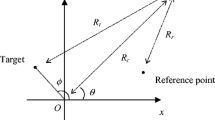Abstract
Different from conventional spaceborne or airborne synthetic aperture radar (SAR) with optimal aperture length, an imaging radar with highly suboptimal aperture length acquires the data in short bursts by a geometry spreading over a large range. A polarlike or pseudopolar format grid is introduced to sample data close to the resolution, which presents the design of a separable kernel for efficient FFT implementation. The proposed imaging algorithm formulates the reflectivity image of the target scene as an interpolation-free double image series expansion with two usual approximation-induced phase error terms being taken into account, whereby more generalized application scenarios with high frequency, large bandwidth or larger aperture length for imaging a target scene located within either the far-field or the near-field of the radar aperture are processable with high accuracy. In addition, convergence acceleration methods in computational mathematics are introduced to accelerate the convergence of the image series expansion, so as to make the algorithm more efficient. The proposed algorithm has been validated both qualitatively and quantitatively with an extensive collection of numerical simulations and field measurements of ground-based SAR (GB-SAR) data set.
Similar content being viewed by others
References
Curlander J C, McDonough, R N. Synthetic Aperture Radar: Systems and Signal Processing. New York: Wiley, 1991
Soumekh M. Synthetic Aperture Radar Signal Processing with Matlab Algorithms. New York: Wiley, 1999
Jungner A. Ground-based synthetic aperture radar data processing for deformationmeasurement. Dissertation for the Master’s Degree. Sweden: Royal Institute of Technology, 2009
Tarchi D, Oliveri F, Sammartino F. MIMO radar and ground-based SAR imaging systems: equivalent approaches for remote sensing. IEEE Trans Geosci Remot Sens, 2013, 51: 425–435
Krieger G, Mittermayer, J, Wendler M, et al. SIREV—sector imaging radar for enhanced vision. In: Proceedings of the 2nd International Symposium on Image and Signal Processing and Analysis, Pula, 2001. 377–382
Klare J, Brenner A R, Ender J H. A new airborne radar for 3D imaging-image formation using the ARTINO principle. In: Proceedings of the 6th European Conference on Synthetic Aperture Radar, Dresden, 2006. 1–4
Wang J, Liang X D, Ding C B, et al. An improved OFDM chirp waveform used for MIMO SAR system. Sci China Inf Sci, 2014, 57: 062306
Fortuny J. A fast and accurate far-field pseudopolar format radar imaging algorithm. IEEE Trans Geosci Remot Sens, 2009, 47: 1187–1196
Brezinski C, Zaglia M R. Extrapolation Methods: Theory and Practice. Amsterdam: North-Holland, 1991
Mahafza B R. Radar Systems Analysis and Design Using MATLAB. London: Chapman & Hall, 2013
Carrara W G, Goodman R S, Majewski R M, et al. Spotlight Synthetic Aperture Radar: Signal Processing Algorithms. Boston: Artech House, 1995
Balanis C A. Antenna Theory: Analysis and Design. New York: Wiley, 2012
Oppenheim A V, Schafer R W, Buck J R. Discrete-Time Signal Processing. Upper Saddle River: Prentice Hall, 1999
Jakowatz C V, Wahl D E, Eichel P H, et al. Spotlight-Mode Synthetic Aperture Radar: a Signal Processing Approach. Norwell: Kluwer Academic Publishers, 1996
Ye Q X, Shen Y H. Practical Methematics Handbook (in Chinese). Beijing: Science Press, 2006
Wynn P. On a device for computing the em(Sn) transformation. Math Tabl Aids Comput, 1956, 10: 91–96
Sidi A. Practical Extrapolation Methods: Theory and Applications. Cambridge: Cambridge University Press, 2003
Sun J Q, Chang X K, He Y, et al. An extended multistep shanks transformation and convergence acceleration algorithm with their convergence and stability analysis. Numer Math, 2013, 125: 785–809
Harris F J. On the use of windows for harmonic analysis with the discrete Fourier transform. Proc IEEE, 1978, 66: 51–83
Hong W, Tan W X, Wang Y P, et al. Development and experiments of ground-based SAR in IECAS for advanced SAR imaging technique validation. In: Proceedings of the 8th European Conference on Synthetic Aperture Radar, Aachen, 2010. 1–4
Author information
Authors and Affiliations
Corresponding author
Rights and permissions
About this article
Cite this article
Han, K., Wang, Y., Chang, X. et al. Generalized pseudopolar format algorithm for radar imaging with highly suboptimal aperture length. Sci. China Inf. Sci. 58, 1–15 (2015). https://doi.org/10.1007/s11432-014-5224-3
Received:
Accepted:
Published:
Issue Date:
DOI: https://doi.org/10.1007/s11432-014-5224-3




